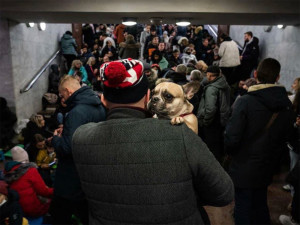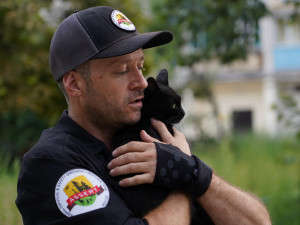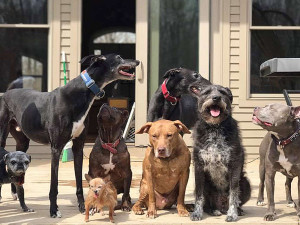No Dogs Left Behind Faces Harsh Realities to Save the Pups Who Need It Most
The rescue organization’s founder Jeff Berri needs your help to save dogs from horrific conditions and giving them a much-deserved new start.
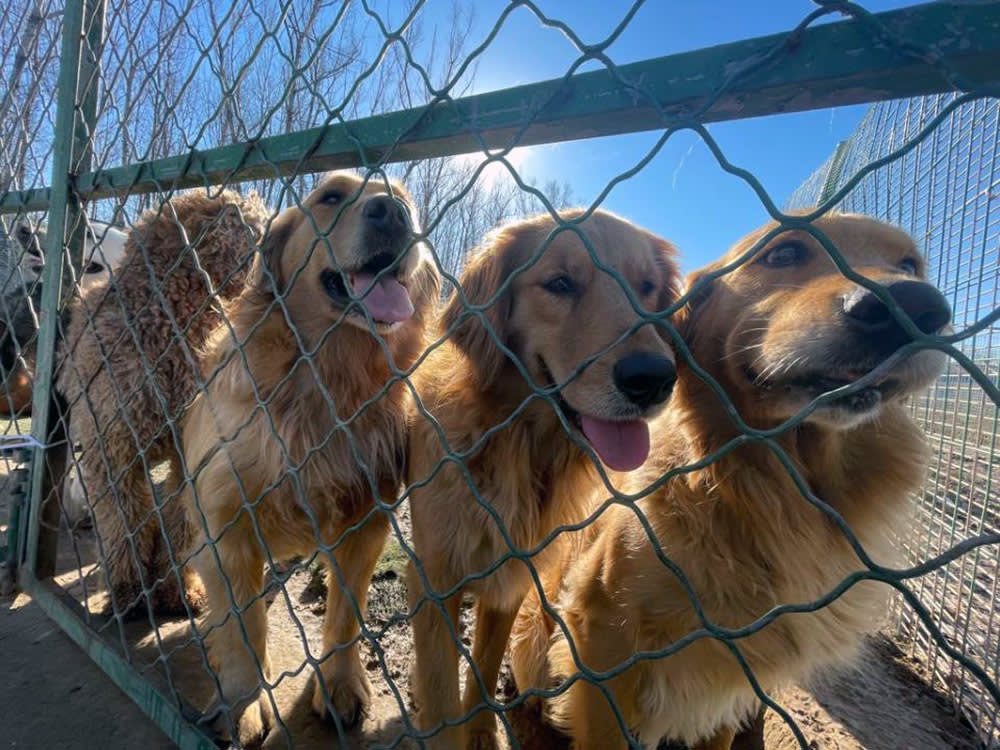
Share Article
Learning about the work of No Dogs Left Behindopens in new tab (NDLB) means facing a lot of ugly truths about how humans treat dogs. From saving dogs who have been beaten, bound with wire, and forced into cages while being transported to be slaughtered in the East Asian meat trade to dogs chained up and neglectedopens in new tab in backyards across America, the organization has seen the worst there is to see in animal rescue.
What’s infinitely harder, however, is actually doing the work rescuing dogs from the most dire situations all over the world. But that’s exactly what NDLB’s Jeff Berri and his team do every day. From the frontlines of war-torn Ukraine to confronting the Taliban in Afghanistan, Berri and hundreds of NDLB volunteers are doing the seemingly impossible work of saving dogs from unthinkable situations, while also rehabilitating them and helping them find permanent homes.

Save on the litter with color-changing tech that helps you better care for your cat.
Berri tells Kinship all about what it takes to run an international organization that takes on some of the most challenging rescues in harsh climates — and how all of us can help.
This interview has been edited and condensed for clarity.
Can you tell us NDLB’s origin story, and how did you originally get involved with animal rescue?
It actually stemmed from watching Cowspiracyopens in new tab, probably in 2015, and better understanding that animal agriculture is one of the leading causes of the deterioration of our planet. I also have a huge passion for animals, particularly dogs, and I was working with rescues and helping them raise money and get dogs adopted. I decided that I wanted to fight for global animal welfare laws; then agains the dog meat trade, as I believe it’s the most barbaric way of slaughtering animals.
There are zero legal slaughterhouses in China, but China has zero animal welfare laws. So, I decided that I would head into East Asia. I was working for a very prestigious jewelry company, but I decided to hang my suit and tie up and go fight on the front lines and, as we say, fight the good fight for global animal welfare laws.
Ever since, No Dogs Left Behind has fought to shut the dog meat trade down, to shut the Yulin festival down. We fight for global animal welfare laws, and we fight on the front lines in regions all over the world. We’ve expanded from China; I confronted the Taliban for 13 days and brought back our war dogs, over 300 animals. We’re positioned in Ukraine; our teams have conducted sterilization campaigns, vaccination campaigns, [identification] campaigns in war-torn areas. We go to the harshest places in the world, places where other rescues fear to go because of the risks of loss of lives.
How exactly does the East Asian dog meat trade work, and what does NDLB do to combat it?
Many dogs are stolen from homes, stolen from the streets, and taken to random warehouses. We gather evidence of the reckless slaughtering. We wait for the right time and the proper amount of volunteers, and then call in the police, mayor, press, and media. We utilize the press and media to showcase the conditions of the animals. One of our biggest rescues was 1,300 dogs.
We have our own NDLB shelters in China, but all of the brave Chinese volunteers and activists lead the way. We sometimes have 100, even 200, volunteers surrounding these facilities. Two Chinese cities are dog meat-free, but we’re fighting for legislation and hoping that additional cities will continue to follow that path and ban dog meat.
What are some of the challenges of running an international rescue operation?
It is quite complex. Logistically, there’s a [good] amount of planning, but you also have to adapt to the realities of life. For example, during COVID, getting dogs out of another country or even moving food from one area to the other was crippling. The cost of transportation soared. We needed to work around it, and we did. We always need to be prepared for challenges and change, and I’m very proud of my team.
NDLB has a five-pillar approach to rescue. How and why did you develop this approach?
The first pillar is what we’re really best at: emergency response, actually engaging in and executing the rescue. Emergency response is critically important, and we take great pride in the way we do it. One example is we’ve never purchased a dog. Many rescues buy dogs — butchers send out messages saying, “If you don’t buy these dogs, we’re going to slaughter them,” they [even show graphic images] that would tear the heart out of anybody. So people feel like, “I’ll just buy those dogs because I want to save their lives.” But buying one dog kills 10. You’re supporting [the slaughterers’] business.
The second pillar is shelter-management protocol. To give them the best chance [at survival] possible, we give the dogs we rescue stability. We give them a regimen where they’re eating on the same schedule, they have park time, they have beds, they have a healthy diet, they’re getting flea and tick [preventative medicine], and are dewormed. They’re being taken care of, and that is extremely important.
The third pillar is education. You can’t imagine how many people we have converted from being fearful of touching a dog to being huge animal advocates. The fourth pillar is fighting for legislation and laws, and the fifth is to get the dogs into their forever loving home. You can save them, but without getting them in their homes, we can’t continue to save lives.
How do you plan to expand NDLB’s work in the U.S.?
We recently opened a kennel in Canton, New York, and we just opened our first shelter and adoption center in Brooklyn. The dogs are flying out, and volunteers are coming in and embracing the shelter.
We are also going to roll out boutique adoption centers all over the country by the end of 2024. They will focus on engaging the local community, engaging adults and youth to come in, have coffee, and chill out with the dogs. You can do your homework while you’re hanging out with dogs, shoot some videos and share them on social media, take them out on a walk and/or come with me on an emergency response.
How do you prepare rescuers to face potentially dangerous rescue situations?
We quantify and qualify people for different rescues. Obviously, we’re not going to bring people to a rescue where they’re in harm’s way or not qualified. Tomorrow, I’m heading out to save a dog from a home where they’re tied up to a tank and have hardly any space. Kids can come with me on that, and they’re not in harm’s way — there’s no combat, though we still have to be safe and cautious. This dog is extremely fearful, and we’re going to pick the dog up and watch this dog be nurtured and learn how to trust humans again.
Volunteers advance and grow. They can come to Ukraine with me — they may not come to the front lines with me where bombs are exploding, but they may work in one of the shelters and transport some dogs across hostile lines — where it’s safe, but it’s still war-torn Ukraine.
That said, volunteers who have been marines and see dogs in such bad shape, can fall to the ground. There have been people who have seen some of the worst and have been crushed. It’s really difficult, but we cry on each others’ shoulders. We’re there for each other. Everyone who has finished an emergency response says they can’t wait to come back and do it again.
How does NDLB decide where to carry out its rescue missions?
We have very strict rules. Everyone who is part of [our intel team] is under strict [non-disclosure agreements], and they’re all around the world. We send up drones. We have people wading through paddy fields, looking through backyards and fences. We are hardline frontline freedom fighters for the voiceless.
Is there a typical type of dog you rescue?
We rescue all dogs: We have purebreds, mixed breeds, we have it all. You have people who want purebreds. And others want the dog who is missing an eye or a leg or an older dog, and I don’t judge anyone for anything. You just hope they understand that these dogs need a home, and they’ve been through so much. They deserve a second chance.
How can people reading this best support NDLB?
Check out our social media feeds — Facebookopens in new tab, Instagramopens in new tab, TikTokopens in new tab — and our websiteopens in new tab. Register to volunteeropens in new tab, donateopens in new tab (we can’t do it without donations), fosteropens in new tab, and adoptopens in new tab.
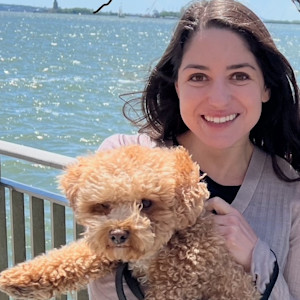
Julie Zeilinger
Julie Zeilinger is a writer and editor whose writing has been published in Marie Claire, Forbes, Vox, HuffPost, and other publications. She is also the author of two books: College 101: A Girl’s Guide to Freshman Year (2014) and A Little F’d Up: Why Feminism Is Not a Dirty Word (2012). She has a two-year-old Bichpoo named Baloo and is a foster mom to dogs via Badass Animal Rescue.
Related articles
![Animal activists hold banners against Yulin Dog Meat Festival in front of Yulin City Representative office in Beijing, China, June 10, 2016.]()
How You Can Help Stop the Yulin Dog Meat Festival
On June 21, thousands of dogs will be slaughtered in Yulin, China. Organizations working to ban this barbaric event need your help to raise awareness now.
![A man holding a dog in a crowded space in Ukraine.]()
How You Can Help Ukraine’s Animals
These Ukrainian rescue organizations need our support. Here’s how to get it to them ASAP.
![Douglas Thron, in his rescue pilot uniform hugging a rescued black cat to his chest outside]()
We Are Now Living in the Age of Drone Animal Rescue
ASSERT is the first on the ground for emergency aid around the world.
![Saharai “Sada” Salazar and a large Belgian Malinois dog who is part of the Wolfmother K9 Rescue.]()
The Fiction of “Unadoptable” Shelter Dogs
Wolf Mother K9 founder Saharai Salazar on misunderstood behaviors, giving every pup a chance, and the need for more empathy.
![]()
How Korean K9 Gives Dogs Rescued From the Meat Trade a Second Shot at Life
The rescue’s founder, Gina Boehler, on her mission to help these pups start over.
![A group of senior dogs sit together.]()
The House That Moses Built
The Mr. Mo Project makes dogs’ golden years their happiest ones.

